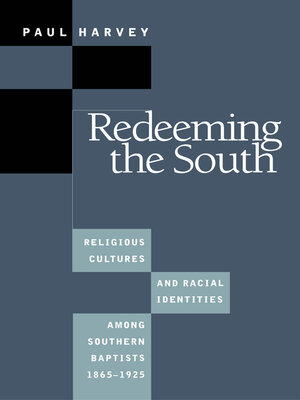Redeeming the South
ebook ∣ Religious Cultures and Racial Identities Among Southern Baptists, 1865-1925
By Paul Harvey

Sign up to save your library
With an OverDrive account, you can save your favorite libraries for at-a-glance information about availability. Find out more about OverDrive accounts.
Find this title in Libby, the library reading app by OverDrive.



Search for a digital library with this title
Title found at these libraries:
| Library Name | Distance |
|---|---|
| Loading... |
Together, and separately, black and white Baptists created different but intertwined cultures that profoundly shaped the South. Adopting a biracial and bicultural focus, Paul Harvey works to redefine southern religious history, and by extension southern culture, as the product of such interaction—the result of whites and blacks having drawn from and influenced each other even while remaining separate and distinct.
Harvey explores the parallels and divergences of black and white religious institutions as manifested through differences in worship styles, sacred music, and political agendas. He examines the relationship of broad social phenomena like progressivism and modernization to the development of southern religion, focusing on the clash between rural southern folk religious expression and models of spirituality drawn from northern Victorian standards.
In tracing the growth of Baptist churches from small outposts of radically democratic plain-folk religion in the mid-eighteenth century to conservative and culturally dominant institutions in the twentieth century, Harvey explores one of the most impressive evolutions of American religious and cultural history.
Harvey explores the parallels and divergences of black and white religious institutions as manifested through differences in worship styles, sacred music, and political agendas. He examines the relationship of broad social phenomena like progressivism and modernization to the development of southern religion, focusing on the clash between rural southern folk religious expression and models of spirituality drawn from northern Victorian standards.
In tracing the growth of Baptist churches from small outposts of radically democratic plain-folk religion in the mid-eighteenth century to conservative and culturally dominant institutions in the twentieth century, Harvey explores one of the most impressive evolutions of American religious and cultural history.







